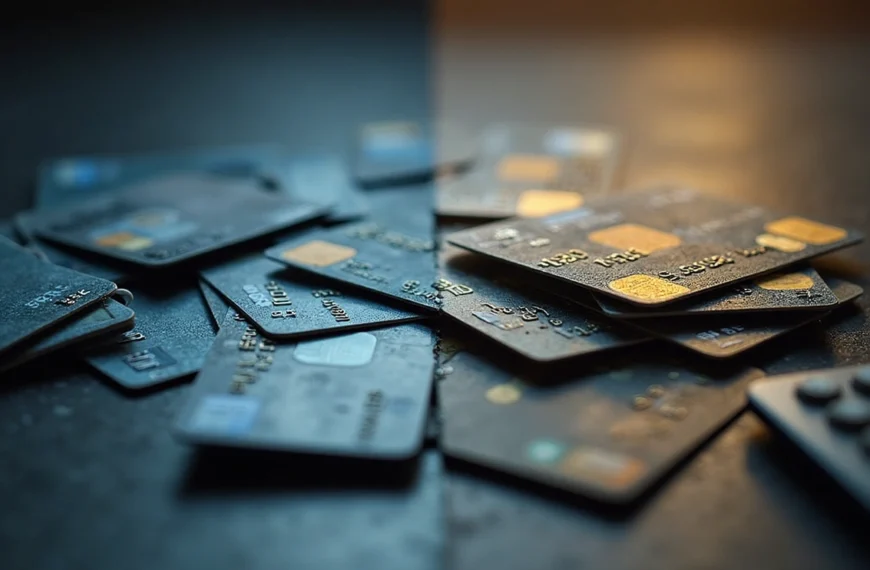Bad credit won’t stop you from getting a loan, even though many people think it will. Credit scores as low as 300 can qualify for personal loans, and some lenders accept people who have no credit history at all. The financial world creates big challenges for these borrowers.
Your creditworthiness determines your interest rates, which range from 6.6% to a whopping 35.99%. Bad credit loans usually come with APRs above 30%, so careful research matters a lot. The numbers tell an interesting story – OneMain Financial gave out more than 51,000 personal loans to LendingTree users in 2024. Upstart helped over 20,000 people get personal loans during this time.
Good news is that lenders look at more than just credit scores these days. Your job history and education now matter more in the approval process. Loan options have grown by a lot too. You can borrow anywhere from $1,000 to $50,000, based on your qualifications and what the lender needs.
This piece shows you the best ways to direct yourself through the 2025 lending market with less-than-perfect credit. You’ll learn practical steps to get a personal loan with bad credit. Homeowners will also discover how to make use of their paid-off property even with credit challenges.
Why Bad Credit Doesn’t Mean No Options
Banks used to turn away people with poor credit scores. Today’s lending landscape looks quite different. Bad credit doesn’t automatically mean you can’t get financing. The lending market has grown to welcome borrowers of all credit profiles, creating new opportunities for people who were once considered too risky.
How lenders assess risk
Credit scores still matter, but today’s lenders look at your complete financial picture. This new approach shows a better understanding of creditworthiness beyond just a FICO score.
Lenders look at these key factors:
Payment history – Your record of paying bills on time plays a big role in their decision
Income stability – A steady job and reliable income show you can handle loan payments
Debt-to-income ratio – This shows what portion of your monthly income goes to existing debts
Length of credit history – More time with credit gives lenders a better view of your money habits
Recent credit activity – Your latest credit applications and borrowing help lenders understand your current situation
Modern lenders use smart algorithms to look at hundreds of data points. These systems check things like your utility payments, rent history, education, and spending patterns. Some lenders even review your bank transactions to verify income and spending habits instead of just credit reports.
This broader approach creates real opportunities for people with bad credit. Someone with a low credit score but steady work and good banking habits might qualify for decent loan terms.
The rise of alternative lending platforms
Financial technology has changed how people with imperfect credit can access loans. These platforms use new ways to assess risk and often cost less to run than traditional banks. This helps them serve people who couldn’t get loans before.
Since 2020, alternative lending options have grown substantially, offering new paths for borrowers with credit challenges:
Fintech lenders create special loans for people with credit issues. Companies like Upstart and Avant use artificial intelligence and machine learning to look at risk differently than banks do. These platforms analyze thousands of data points beyond credit scores, including education, work history, and even how carefully applicants complete their forms.
Peer-to-peer lending networks link borrowers directly with investors who fund loans. Without banks in the middle, terms can be more flexible for people with credit problems. Investors can make more personal lending decisions instead of following strict bank rules.
Credit unions often have more flexible rules than big banks. As member-owned organizations, they focus more on helping members than making profits. They might look past a poor credit score if other factors look good.
Community development financial institutions (CDFIs) help underserved communities. They offer loans designed for people who struggle to get traditional financing.
Digital lending has made applying for loans easier. Online applications, quick approvals, and electronic documents have simplified what used to be a complex process. Many alternative lenders can tell you if you’re approved in minutes.
These changes help consumers in several ways. More lenders mean more competition, which leads to better loan options. You’ll find specialized loans for different needs, from combining debts to covering emergencies, even with credit challenges.
Bad credit still affects loan terms and interest rates, but you now have options to compare instead of taking the first offer you get. This power to shop around marks a big improvement from when bad credit meant no loans at all.
Know Your Loan Options in 2025
Image Source: The Business Research Company
The 2025 financial world gives borrowers with credit challenges several good options. Lending technology has made it easier to get financing. This means new chances for people who don’t have great credit scores.
Enable loans and fintech lenders
Digital lending platforms have changed how people get credit through new ways to check risk. These fintech companies use artificial intelligence and different data sources to review borrowers beyond their credit scores.
Upstart leads the way by taking applicants with credit scores as low as 300 and people with no credit history [1]. Their AI system looks at things like education and job history to make loan decisions. You can get personal loans between $1,000 and $50,000, with APRs from 6.6% to 35.99% [1].
Possible Finance shows how new fintech lenders help more people get loans. They give small installment loans without running FICO checks, which makes them available to people with bad credit [2]. They also report your payments to credit bureaus, so you can build better credit by paying on time.
MoneyMutual and other online marketplaces link borrowers to lenders who work with tough credit cases. These platforms usually just do soft credit checks, which keeps your score safe while you look for options [2].
Personal loans for bad credit
Many old lenders now have special personal loans for people with credit problems:
Avant takes credit scores down to 580 and gives loans from $2,000 to $35,000 with APRs between 9.95% and 35.99% [1]. They’re quick too – you often get your money the next business day after approval [1].
OneMain Financial helps people with poor or fair credit scores by offering loans from $1,500 to $20,000 [1]. They don’t say what the lowest credit score can be, but they care more about whether you can pay back the loan. You can choose terms from 24 to 60 months [1].
Oportun helps people with little or no credit history by offering small loans starting at $300 [1]. You don’t need a credit history to apply – they just check your income and bank account [3].
Universal Credit designs loans for people with credit scores as low as 560. You can borrow between $1,000 and $50,000 [1]. They give you tools to track and improve your credit over time.
Home equity and secured loans
Homeowners who have built up equity might get home equity loans even with credit issues. Most lenders want a credit score of at least 620, but some will look at lower scores [4].
Lenders check these things when you ask for a home equity loan with bad credit:
- Your home equity (you usually need 15-20%) [4]
Loan-to-value ratio (usually stops at 85-90%) [4]
Debt-to-income ratio (can’t go above 43%) [4]
How steady your job and income are
Secured personal loans give another option if you have credit problems. You need collateral—like a car, savings account, or CD. This makes the loan safer for lenders, so you’re more likely to get approved and get better interest rates than with unsecured loans.
Upgrade, Best Egg, and OneMain Financial offer secured personal loans with easier credit rules [5]. Upgrade takes borrowers with scores as low as 580 if they use their car as collateral [5].
Credit unions offer share-secured loans backed by your savings account if you don’t have other collateral [5]. You can’t use that money while it’s backing the loan, but it’s a good way to rebuild credit with better rates.
How to Get a Personal Loan with Bad Credit
Image Source: Investopedia
Bad credit shouldn’t stop you from getting a personal loan. Your approval chances improve by a lot when you know the exact steps and requirements. Here’s how you can get a personal loan even with credit challenges.
Step-by-step application process
The path to getting a personal loan with bad credit follows these steps:
Check your credit report and score – You should know where you stand before applying. Many credit card companies and lenders give free access to credit scores. Look for errors in your credit reports that might hurt your score and challenge any mistakes with each credit bureau.
Research lenders with flexible requirements – Find lenders who work with credit-challenged borrowers. Online lenders accept scores as low as 580. Some lenders like Upstart might approve you with scores as low as 300 or even without a credit history [6].
Use prequalification options – Submit prequalification forms that use soft credit inquiries whenever possible. These don’t affect your score. You can compare potential offers without hurting your credit [7]. Many online platforms let you see multiple offers at once.
Compare loan offers carefully – Take time to review interest rates, origination fees, repayment terms, and total loan cost. Pick an offer that fits your budget with manageable monthly payments and lowest overall cost [7].
Submit a formal application – Complete the official application after picking your best option. This creates a hard credit check that temporarily affects your credit score [8].
Review and accept loan terms – Read all loan documents carefully before signing. Make sure you understand the payment schedule, possible fees, and all terms and conditions.
Receive your funds – Money goes directly into your bank account after acceptance. This could happen within 24 hours or take up to 10 business days [7].
Documents you’ll need
Lenders need specific documents to verify your identity and finances:
Identification documents – Government-issued photo ID such as driver’s license, passport, state ID, or military ID [9]
Proof of income – Recent pay stubs, W-2 forms, tax returns, or bank statements that show regular deposits [10]
Verification of residence – Utility bills, mortgage statements, lease agreements, or other documents that prove your address [11]
Banking information – Account numbers and routing details for loan deposit and automatic payments [9]
Social Security Number – Required for identity verification and credit checks [10]
Secured loans need extra documents to prove you own the collateral.
Tips for faster approval
These strategies can help you get approved for a personal loan despite credit issues:
Think about adding a co-signer or co-borrower with better credit. Co-signers take equal responsibility if you default. Co-borrowers share both payment duties and access to funds [12]. This can boost your approval odds and get you better terms.
Choose a secured personal loan if your credit score is very low. These loans need collateral like your car, savings account, or other valuable assets. This reduces the lender’s risk and makes approval more likely [12].
Apply during business hours to speed up processing. Send all required documents quickly to avoid delays [7].
Cut your debt-to-income ratio before applying by paying off existing debts. Lenders look closely at this number to see if you can handle more payments [13].
Double-check all application information before submitting. Wrong details or missing information could lead to automatic rejection, whatever your other qualifications [12].
Set up automatic payments if you can. Many lenders give interest rate discounts when you set up automatic withdrawals. This also helps you avoid late payments [8].
Smart Ways to Compare Loan Offers
Image Source: MLS Mortgage
Bad credit borrowers need to look beyond advertised interest rates to evaluate multiple loan offers. Lenders might show similar offers that end up having very different costs after a closer look. You can save thousands of dollars over your loan’s lifetime by knowing how to compare these offers properly.
Understanding APR vs. interest rate
The difference between interest rate and Annual Percentage Rate (APR) remains one of the most confusing parts of loan comparison. These related terms measure different things:
Interest rate: The percentage that determines your cost of borrowing the principal loan amount
APR: The total yearly cost of your loan, including both interest and additional fees [14]
Credit cards usually treat these terms as the same thing. But personal loans are different – the APR is a big deal as it means that the interest rate because it includes origination fees and other charges [15]. APR gives you a better way to compare loans.
Here’s a simple example: Two lenders both offer 10% interest rates on five-year loans. The first one charges a 3% origination fee while the second charges 5%. Even with the same interest rates, the second loan’s APR turns out higher [16]. APR tells you the true cost better than the base interest rate.
Loan term and monthly payment trade-offs
Loan terms directly affect your monthly payments and total interest:
Shorter terms usually have lower interest rates but higher monthly payments
Longer terms give you smaller monthly payments but cost more in total interest
You should calculate both monthly payments and total repayment amounts to understand term options. This helps you see if you can afford the loan and what it costs long-term [16].
Your debt-to-income ratio plays a vital role in this choice. This number shows how much of your monthly income goes to debt payments and helps you figure out an affordable monthly payment [17].
Origination and late fees to watch
Lenders charge origination fees upfront to process your loan, usually 1% to 6%, though some charge up to 10% [18]. They take these fees from your loan amount before giving you the money. A $10,000 loan with a 5% origination fee means you’ll get $9,500 [19].
Watch out for these common fees:
Late payment fees: Usually $15-$25 or 5% of the payment amount after grace periods (usually 10-15 days) [20]
Returned payment fees: These hit when automatic payments fail [20]
Application fees: Good lenders don’t charge these – they often signal predatory lending [20]
Prepayment penalties: Trustworthy lenders rarely charge fees for early loan repayment [20]
Make sure origination fees are part of the APR calculation when comparing offers. Adding these fees separately to the APR makes costs look higher than they are [16].
Borrowers with fair or good credit might find no-fee personal loans. Even with bad credit, you might discover options with lower or no origination fees by shopping around [18].
Setting up automatic payments can lower interest rates by 0.25% to 0.5% [7]. This gives you a chance to cut costs while making timely payments that boost your credit score.
Boost Your Approval Chances Before Applying
Smart moves before you apply for a loan can boost your chances of approval if you have credit issues. These steps make your application stronger and can help you get better interest rates and loan terms.
Pay down existing debt
Lowering your current debt is one of the quickest ways to make your loan application stronger. Lenders look closely at your debt-to-income (DTI) ratio—how much of your monthly income goes to debt payments. Your best chance of approval comes when this number stays below 36% [12].
Lenders worry about high credit card balances for several reasons:
They push up your credit utilization ratio, which affects your credit score by a lot
They show lenders you might be having money troubles
They limit how much new debt you can handle
The best strategy is to pay off your highest-interest credit cards first using the avalanche method, or tackle the smallest balances for quick wins with the snowball method [21]. Even small reductions in your credit card debt can make a real difference in your DTI ratio.
The timing of your debt paydown matters. You should start paying down debt at least six months before you apply for a loan. This gives credit reporting agencies enough time to update your financial profile [21].
Avoid new credit inquiries
When you apply for credit, it usually creates “hard inquiries” that drop your credit score temporarily. Each hard inquiry can knock a few points off your score and stays on your credit report for two years [22]. Multiple recent inquiries make lenders nervous because it looks like you’re trying to take on too much debt.
Mortgage and auto loans work differently. Credit scoring models usually count multiple inquiries within a certain timeframe as just one inquiry. FICO gives you 45 days, while VantageScore gives you 14 days [22]. Personal loans don’t always get this special treatment.
Here’s how to time your applications:
Don’t apply for new credit 6-12 months before you need a major loan
Look for prequalification options that use “soft inquiries” instead
Submit formal applications only after you’ve done your homework
Note that checking your own credit score won’t hurt your numbers, so keep an eye on it throughout this process [23].
Add a co-signer or collateral
Getting a qualified co-signer can boost your approval odds, especially if your credit score isn’t great. A good co-signer should have:
A credit score of at least 670 (700+ is better)
A low debt-to-income ratio (under 36% is ideal)
Steady income and job history
A good grasp of what they’re signing up for [24]
Co-signers can help you get much better terms—like lower interest rates and bigger loans. Some lenders offer special co-signer deals, like Achieve, which cuts APR by up to 5.5% for joint applications [25].
Another option is to back your loan with collateral. This cuts the lender’s risk and often leads to approval when unsecured loans wouldn’t work [26]. You can usually use:
Vehicles (for auto-secured personal loans)
Savings accounts or certificates of deposit
Home equity (if you own a home)
Secured loans usually come with lower interest rates than unsecured ones for people with similar credit [27]. Just remember that if you default, you could lose whatever assets you put up as collateral.
What to Do If You’re Denied
A loan rejection feels discouraging, but it doesn’t mean the end of your borrowing options. Your loan denial can teach you valuable lessons about what needs improvement before you apply again. The challenges you face are common – 37% of Americans have subprime credit scores below 670, and many successfully secure financing later.
Rebuilding credit before reapplying
Your credit score will improve with patience and dedication. Ask your lender why they denied your application – they must provide this information when you ask. Most denials happen due to high debt, low income, or too many recent credit applications.
These strategies will help rebuild your credit:
Establish perfect payment history by setting up automatic payments for all existing accounts
Reduce credit utilization to below 30% of available credit limits
Become an authorized user on a family member’s credit card with good history
Review your credit reports to find errors that might hurt your score
Allow time for recovery – late payments and other negative marks have less effect after 12-24 months
Your credit profile needs at least six months to show these improvements before you apply again.
Learning about credit builder loans
Credit builder loans work differently from regular loans and help build or rebuild credit history without needing good credit first. These loans keep your borrowed money in a locked savings account while you make payments, unlike traditional loans that give you money upfront.
Your payment history gets reported to credit bureaus, which builds positive credit over time. The funds and any earned interest become available after you complete all payments. Most loans range from $300 to $1,000 with 6-24 month terms.
Credit unions offer these products with low fees, while online providers like Self and MoneyLion make them available to more people across all locations.
Using credit unions or family loans
Credit unions have more flexible lending rules than traditional banks. They focus on member service over profits since members own these nonprofit organizations. Many have “second chance” programs specifically for members working to rebuild credit.
Family loans can help when other options aren’t available. Make these arrangements official with proper documentation:
Written agreement showing loan amount, interest rate, and payment schedule
Clear consequences for missed payments
Optional services like Zirtue to handle payments and reporting automatically
Family loans might feel awkward at first, but a well-structured agreement can provide financial support while building good payment history.
Avoiding High-Risk Loan Traps
Dangerous loan traps still catch many consumers who need quick money, even though legitimate lending options have grown for people with poor credit histories. You should know these risks before you borrow any money.
Why payday loans are risky
Payday loans rank among the most dangerous ways to borrow money because they cost so much. These short-term loans come with Annual Percentage Rates (APRs) between 390% to 780% [28]. Borrowers must pay back the money within 30 days, and loan amounts range from $100 to $1,000 [28].
The biggest problem starts when people roll over their loans. Almost 80% of customers take out more loans [28]. Each new loan adds extra fees. Borrowers end up paying nowhere near the original amount as debt spirals out of control. A 2019 study shows that payday loans doubles the rate of personal bankruptcy [28].
How to spot predatory lenders
Your financial future depends on spotting predatory lending practices early. Here are the warning signs you should watch:
They rush you through approval with pressure tactics [29]
The loan terms are confusing or don’t match [29]
Interest rates and origination fees seem too high [29]
They want you to borrow more than you need [29]
You face penalties for early payment [29]
Monthly payments don’t cover the interest [29]
A lender might be trouble if they push you to decide quickly or dodge your questions [28].
Alternatives to avoid debt cycles
You have several safer options when you need money:
Credit unions give personal loans with better interest rates and flexible terms [30]. Many help members rebuild their credit through “second chance” programs.
You can work directly with creditors to lower your monthly payments without new loans [31]. Medical facilities often let you pay over time without interest [3].
Nonprofit and charitable groups help with basic needs like food, utilities, and housing [3].
Learning about compound interest helps protect you from predatory lenders [32]. Financial knowledge lets you review loan terms better and stay away from risky products that trap you in debt.
Can I Get a Loan If My House Is Paid Off?
Image Source: Bankrate
Homeowners who’ve paid off their mortgages have a valuable financial asset that opens doors to borrowing, even with credit issues. A fully paid home with 100% equity makes securing a loan much easier compared to those without such collateral.
Using home equity with bad credit
Your home equity offers a compelling borrowing option if you have poor credit scores. Most home equity lenders want a minimum credit score of 620, though some accept applications from borrowers with lower scores [4]. Here’s what you need to qualify:
At least 15-20% equity retention after borrowing [33]
Loan-to-value (LTV) ratio typically capped at 80-85% [34]
Debt-to-income ratio below 43% [4]
To name just one example, a home worth $400,000 with no mortgage might qualify you to borrow up to $340,000 ($400,000 × 85%) [34]. Of course, a paid-off home strengthens your financial profile as a borrower and could lead to better interest rates [1].
Risks of secured loans
The stakes rise much higher with home-secured loans compared to unsecured debt. Credit card defaults mainly lead to late fees and credit score damage, but failing to repay a home equity loan could result in foreclosure [2]. You should also know about these risks:
Your credit score might fluctuate at first because a large home equity loan increases your available credit utilization [2]. This could make qualifying for other loans harder temporarily.
A secured loan turns your valuable asset into a financial obligation [2]. Many borrowers see home equity as an easy fix for consolidating debt without fixing why it happens in the first place [2].
When it makes sense to borrow
Home improvements stand out as one of the smartest uses for home equity funds. We used these loans mainly because the interest paid may be tax-deductible for IRS-eligible projects [35]. On top of that, it makes financial sense to consolidate high-interest debt given the stark interest rate differences—home equity loans average just over 8% compared to nearly 23% for credit cards [35].
Notwithstanding that, using home equity for things that lose value, like vacations or vehicles, isn’t usually a good move [34]. These situations put your home at risk without any long-term financial benefits.
Note that you should verify your ability to make consistent payments, especially when you have retirement approaching [1]. Your access to equity might provide immediate funds, but it creates a new financial obligation where none existed before.
Conclusion
Final Thoughts on Securing Loans Despite Credit Challenges
Bad credit makes getting a loan challenging. Yet borrowers with credit difficulties have several viable options. The lending landscape has altered the map and created opportunities where traditional doors were once closed.
Your current credit situation is the foundation of any successful loan application. A realistic approach starts with checking your credit report. You should spot errors and know your score before talking to lenders. The market has lenders who look beyond conventional credit scores, which can boost your approval chances.
Personal loans for bad credit provide practical solutions ranging from $1,000 to $50,000 based on qualifications. Companies like Upstart, Avant, and OneMain Financial have created products for credit-challenged borrowers. Some accept scores as low as 300.
Smart comparison shopping becomes your most powerful strategy with imperfect credit. Small differences between offers add up to thousands over your loan’s lifetime. The APR tells you the true cost of borrowing rather than just the interest rate.
Homeowners with paid-off properties have a big advantage through home equity options. Their equity serves as substantial collateral to overcome credit challenges. The potential risks of default need careful consideration.
Good preparation helps both approval odds and loan terms. You can turn borderline applications into approvals by paying down existing debt. Avoiding new credit checks and finding co-signers or collateral helps too. Staying away from predatory lending protects vulnerable borrowers from dangerous debt cycles.
Credit obstacles rarely block all financial options forever. Borrowers can find budget-friendly solutions despite past financial difficulties. They need strategic credit improvement plans and realistic research. The alternative lending market keeps creating new opportunities for people who couldn’t get traditional financing.
Patience and persistence pay off when dealing with credit challenges. Each application teaches valuable lessons for future attempts. Without doubt, millions of Americans have gotten loans despite imperfect credit histories. Financial opportunities remain available with the right approach and realistic expectations.
FAQs
Q1. What credit score do I need to get a personal loan in 2025? While some lenders may accept scores as low as 300, most require a minimum score of 580-620 for personal loans. However, fintech lenders like Upstart are increasingly using alternative data to evaluate borrowers beyond just credit scores.
Q2. How can I improve my chances of getting approved for a loan with bad credit? To boost approval odds, focus on paying down existing debt, avoiding new credit inquiries, and considering adding a co-signer or collateral. You can also look into secured loan options or credit builder loans to help rebuild your credit profile.
Q3. Are there alternatives to payday loans for people with bad credit? Yes, safer alternatives include personal loans from credit unions, payment plans negotiated directly with creditors, and assistance from nonprofit organizations. These options typically have much lower interest rates and fewer risks than payday loans.
Q4. Can I get a loan using my paid-off house as collateral? Homeowners with fully paid-off properties can often qualify for home equity loans or lines of credit, even with less-than-perfect credit. Most lenders require a minimum credit score of 620, though some may consider lower scores if you have significant equity.
Q5. What should I look for when comparing loan offers for bad credit? Focus on the Annual Percentage Rate (APR) rather than just the interest rate, as it includes fees. Also, compare loan terms, origination fees, and prepayment penalties. Be wary of predatory lenders using pressure tactics or offering unclear terms.
References
[1] – https://www.bankrate.com/home-equity/get-equity-paid-off-home/
[2] – https://www.bankrate.com/home-equity/home-equity-loan-risks-and-how-to-avoid-them/
[3] – https://www.incharge.org/debt-relief/payday-loan-alternatives/
[4] – https://www.lendingtree.com/home/home-equity/home-equity-loan-bad-credit/
[5] – https://www.nerdwallet.com/best/loans/personal-loans/secured-personal-loans-lenders
[6] – https://www.lendingtree.com/personal/best-personal-loans-for-bad-credit/
[7] – https://www.cnbc.com/select/personal-loans-to-apply-credit-score-580-or-lower/
[8] – https://www.investopedia.com/the-best-personal-loans-for-bad-credit-8761245
[9] – https://www.bankrate.com/loans/personal-loans/documents-required-for-personal-loan/
[10] – https://www.wellsfargo.com/personal-loans/checklist/
[11] – https://www.onemainfinancial.com/resources/loan-basics/what-documents-do-you-need-to-apply-for-a-personal-loan
[12] – https://www.bankrate.com/loans/personal-loans/boost-chances-of-personal-loan-approval/
[13] – https://www.bankrate.com/loans/personal-loans/how-to-get-a-bad-credit-loan/
[14] – https://www.consumerfinance.gov/ask-cfpb/what-is-the-difference-between-a-loan-interest-rate-and-the-apr-en-733/
[15] – https://www.discover.com/credit-cards/card-smarts/apr-vs-interest-rate/
[16] – https://www.bankrate.com/loans/personal-loans/personal-loan-origination-fees/
[17] – https://www.bankrate.com/loans/loans-comparison-calculator/
[18] – https://www.lendingtree.com/personal/best-no-fee-personal-loans/
[19] – https://www.nerdwallet.com/best/loans/personal-loans/best-bad-credit-loans
[20] – https://www.lendingtree.com/personal/understanding-origination-fees/
[21] – https://mortgagesolutions.net/2024/09/13/credit-card-debt-apply-for-home-loan/
[22] – https://www.experian.com/blogs/ask-experian/do-multiple-loan-inquiries-affect-your-credit-score/
[23] – https://www.consumerfinance.gov/ask-cfpb/what-exactly-happens-when-a-mortgage-lender-checks-my-credit-en-2005/
[24] – https://www.experian.com/blogs/ask-experian/can-you-get-a-personal-loan-with-a-cosigner/
[25] – https://www.lendingtree.com/personal/best-personal-loans-for-a-cosigner/
[26] – https://www.lendingtree.com/personal/how-do-collateral-loans-work/
[27] – https://focusok.com/loans/collateral-loans/
[28] – https://www.investopedia.com/terms/p/predatory_lending.asp
[29] – https://myhome.freddiemac.com/blog/homebuying/spotting-and-preventing-predatory-lending
[30] – https://blog.massmutual.com/planning/dangers-payday-loans
[31] – https://www.cnbc.com/select/best-payday-loan-alternatives/
[32] – https://www.ombbank.com/blog/whats-the-key-to-breaking-the-debt-cycle
[33] – https://www.bankrate.com/home-equity/home-equity-loan-bad-credit/
[34] – https://www.experian.com/blogs/ask-experian/how-to-get-equity-out-of-paid-off-house/
[35] – https://www.cbsnews.com/news/reasons-to-borrow-home-equity-from-a-paid-off-home/













![No Win No Fee Lawyers: The Hidden Truth About Settlement Cuts Legal representation through no win no fee lawyers gives clients a way to fight cases without paying anything upfront. Many clients don't know that these services take a big chunk of money after winning the case. Lawyers usually take 25% to 40% of what you win as their contingency fee. The amount lawyers take from settlements can add up fast. A $100,000 settlement means your attorney gets $30,000 if they charge a 30% fee after winning your case. Your solicitor's cut might be £10,000 from a £30,000 compensation award, based on your agreement percentage. This payment model stays pretty much the same for no win no fee lawyers in different places, though percentages can change. This piece breaks down what you need to know about contingency fee deals. You'll learn about standard fee ranges, extra costs beyond the basic fee, and times when this payment setup might not work in your favor. Smart clients should think over these money matters before signing up with a lawyer to make better choices about their legal help. What No-Win No-Fee Really Means Image Source: Express Legal Funding A no-win no-fee arrangement, also called a Conditional Fee Agreement, changes the way people get legal help. This payment approach removes the need to pay legal fees upfront and creates a partnership between clients and their attorneys. How contingency fees work No-win no-fee agreements are based on contingency fees. Lawyers get paid only when they win compensation for their clients. Most lawyers take between 25% and 40% of the final amount, based on how complex the case is and where it's filed. Lawyers take their cut after winning the case. To name just one example, see a case where a lawyer wins £30,000 in compensation with a 33% fee - they would receive £10,000. On top of that, some law firms use sliding scales where they charge less for quick settlements and more if the case goes to trial. The law requires a written agreement before any work starts. This paperwork spells out the lawyer's percentage, what costs you'll need to cover, and other key details. What happens if you lose the case The meaning behind "no-win no-fee" is clear - losing your case means you won't pay your lawyer anything. All the same, you should know about a few money-related details. You won't owe your lawyer when you lose, but some deals might make you pay for court fees, expert witnesses, or other case expenses. The other side could also ask you to pay their legal costs. Many lawyers suggest getting "After Event" insurance to protect their clients. These policies cover any costs if you lose your case, which makes the no-win no-fee setup much safer. Why lawyers offer this model Lawyers want to make legal help available to more people, so they offer these payment plans. This setup helps people who don't have much money take legal action when they have valid claims. The payment structure motivates lawyers to work hard. They only get paid by winning cases, which pushes them to get the best results possible. Lawyers carefully assess each case before taking it on a no-win no-fee basis. They usually accept cases that have a good chance of winning, since they put in lots of time and resources without any guaranteed payment. The Real Cost: How Much Do Lawyers Take from a Settlement Image Source: Greiner Law Corp. The true cost of no-win no-fee legal representation becomes clear once we look at contingency fees. Many clients feel surprised to see a big chunk of their settlement checks going to their attorney's fees. Typical percentage ranges (25%–40%) No win no fee lawyers typically ask for 25% to 40% of the total settlement amount. Personal injury attorneys usually take 33.3% (one-third) of the awarded compensation[101]. Lawyers and clients agree on this percentage before any work starts on the case. Several factors shape the final percentage. Your chances of winning, case complexity, and the work to be done play key roles in determining the attorney's cut. Some areas have laws that cap the maximum contingency fees for specific types of cases. Sliding scale based on case complexity Law firms often use a tiered fee system that changes with the case stage and complexity. This scale rewards quick settlements while paying attorneys fairly if more work becomes needed. The fee might start at 30% if the case settles before lawsuit filing. This number could climb to 35% after filing or reach 40% if the case goes to trial. Law firms often group cases by complexity: 10%-20%: Simple cases with straightforward settlements 25%-35%: Typical personal injury cases 35% and above: Complex cases requiring extensive resources Examples of payout breakdowns These ground examples show how fees affect settlements: A $15,000 settlement with a 33.3% contingency fee.pdf) puts $5,000 in the attorney's pocket, leaving $10,000 for the client. Similarly, from a $100,000 settlement with a 33% fee, the attorney gets $33,000 while the client receives $67,000[102]. Complex cases tell a different story. A $100,000 settlement with a 30% fee plus $5,000 in extra costs leaves $65,000 for the client after all deductions. These fees substantially change the client's final payout. Hidden Costs You Might Not Expect Image Source: Nelson Personal Injury Lawyers Beyond percentage-based fees, clients often feel surprised by extra costs that can reduce their final compensation by a lot. These hidden costs show up in the fine print of no-win no-fee agreements. You should think over these details before signing. Court filing and expert witness fees Legal proceedings come with unavoidable court filing fees. These charges differ by jurisdiction. They usually range from $30 for small claims to several hundred dollars for complex civil lawsuits. Expert witnesses can be expensive, with hourly rates ranging from $150 to $1,000 based on their credentials and testimony complexity. Expert witnesses charge more for court appearances than consultation work because of added pressure and prep time. Clients might still need to pay experts for their prep work even if the case settles before trial. Medical report and investigation costs Medical documentation is a vital part of many legal claims. These costs include fees to release medical records, create specialized reports, and prepare documents. Investigation costs cover evidence gathering, police reports, witness interviews, and other fact-finding work needed to build a strong case. Of course, some firms say they'll cover these expenses upfront, but clients don't completely avoid these costs. When these costs are deducted from your compensation Law firms take these expenses from the settlement amount before they calculate their percentage fee, though each firm handles this differently. Some lawyers subtract these costs after figuring out their contingency fee, which changes how much money clients end up with. Most firms pay case-related costs during the process and get their money back from the settlement. The defendant usually pays most simple legal costs and disbursements in successful cases, but not always everything. Insurance protects clients from costs in unsuccessful claims at many law firms, but this protection isn't guaranteed. Clients should review their agreements carefully since they might still need to pay specific expenses even if they lose their case. When No-Win No-Fee Might Not Be the Best Option Contingency fee arrangements give many people access to justice. However, this payment model doesn't always work in a client's best interests. Knowing these limitations helps clients make better decisions about their legal representation. Cases with unclear liability Lawyer no win no fee arrangements work best in cases where fault is clear. We assessed the probability of success before taking contingency cases. Lawyers might turn down cases if there isn't enough evidence of the other party's negligence or if liability isn't certain. Cases with multiple responsible parties create more challenges. The situation gets complicated fast when several parties share liability. Lawyers are less likely to take these cases on contingency. They need to be confident they can prove the other party's negligence before accepting a case. Low-damage or low-payout claims Small claims often don't work well with the contingency model, even with real injuries. Cases that have minimal injuries or limited financial damages might not bring enough compensation to cover legal costs. The potential settlement needs to be big enough to pay for investigations, witness interviews and court fees. Personal injury lawyers often turn down cases where the "compensation potential" is too small. This doesn't mean the claim isn't valid - it just means the economics don't add up for a contingency arrangement. Situations where hourly billing may be better Hourly billing has clear advantages in certain cases. Clients see exactly what they're paying for - every hour worked and task completed. This model works well for cases that need lots of attention but don't have clear financial outcomes. Complex litigation with opposing parties works better with hourly billing and a retainer fee. Clients have more control over their case and don't feel pressured to settle quickly. Cases that need extensive preparation but have uncertain outcomes fit the hourly model better. Lawyers can spend the time needed without worrying about contingency limits. This approach often leads to better representation, especially for complex legal issues that need special expertise. Conclusion Understanding the Full Picture Before You Sign No-win no-fee arrangements offer legal representation without upfront costs. Of course, this seems attractive at first glance. In spite of that, you need to think about how these agreements can affect your final compensation. Legal fees usually range from 25% to 40% of your settlement - but that's just the start. You'll face more deductions like court filing fees, expert witness costs, and charges for medical documentation. What looks like a "free" service ends up taking a big chunk of your compensation to cover legal expenses. These arrangements work best in specific situations - cases with obvious liability, substantial damages, and solid evidence. If you have a low-value claim or complex liability issues, traditional hourly billing might serve you better. Without doubt, you should ask for clear explanations of all possible costs before signing anything. Read the fine print closely, especially when you have to deal with expenses in unsuccessful cases. Ask to see sample settlement breakdowns that show all deductions. This helps you picture what you might actually take home. Your choice to go with a no-win no-fee arrangement depends on your situation. This model helps if you don't have money to pursue valid claims. But if you have a strong case and enough funds, other fee structures might let you keep more of your compensation. Whatever payment model you choose, knowing exactly how much lawyers take from settlements helps you make better decisions. This knowledge lets you approach legal representation with real expectations and better control over your money. FAQs Q1. What percentage of a settlement do no-win no-fee lawyers typically take? No-win no-fee lawyers typically charge between 25% to 40% of the final settlement amount as their contingency fee. The exact percentage often depends on the complexity of the case and the stage at which it is resolved. Q2. Are there any hidden costs in no-win no-fee arrangements? Yes, there can be additional costs beyond the lawyer's percentage fee. These may include court filing fees, expert witness costs, medical report expenses, and investigation costs. These expenses are usually deducted from the settlement amount before or after the lawyer's fee is calculated. Q3. What happens if I lose my case in a no-win no-fee arrangement? If you lose your case, you generally won't have to pay your lawyer's fees. However, you might still be responsible for certain expenses like court costs or the opposing party's legal fees. Many lawyers offer insurance to protect clients from these potential costs in case of an unsuccessful claim. Q4. When might a no-win no-fee arrangement not be the best option? No-win no-fee arrangements may not be ideal for cases with unclear liability, low-value claims, or complex legal issues requiring extensive preparation. In these situations, traditional hourly billing might be more appropriate and potentially more cost-effective for the client. Q5. Can I negotiate the percentage a lawyer takes from my settlement? Yes, the contingency fee percentage is often negotiable. It's typically agreed upon and formalized in writing before the lawyer begins working on your case. Don't hesitate to discuss the fee structure with your lawyer and ask for a detailed breakdown of potential costs and deductions.](https://consumersweek.com/wp-content/uploads/2025/06/No-Win-No-Fee-Lawyers-The-Hidden-Truth-About-Settlement-Cuts-870x570.webp)



